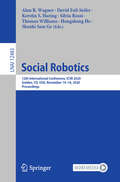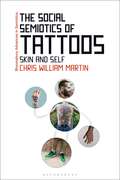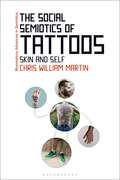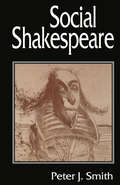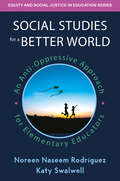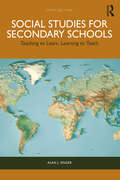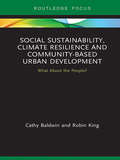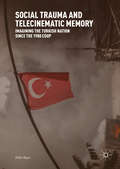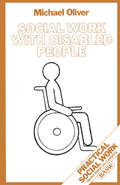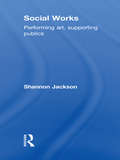- Table View
- List View
Social Robotics: 14th International Conference, ICSR 2022, Florence, Italy, December 13–16, 2022, Proceedings, Part I (Lecture Notes in Computer Science #13817)
by Filippo Cavallo John-John Cabibihan Laura Fiorini Alessandra Sorrentino Hongsheng He Xiaorui Liu Yoshio Matsumoto Shuzhi Sam GeThe two-volume set LNAI 13817 and 13818 constitutes the refereed proceedings of the 14th International Conference on Social Robotics, ICSR 2022, which took place in Florence, Italy, in December 2022. The 111 papers presented in the proceedings set were carefully reviewed and selected from 143 submissions. The contributions were organized in topical sections as follows: Social robot navigation and interaction capabilities (voice, tactile); Social robot perception and control capabilities; Investigating non verbal interaction with Social robots; Foster attention and engagement strategies in social robots; Special Session 1: Social Robotics Driven by Intelligent Perception and Endogenous Emotion-Motivation Core; Special Session 2: Adaptive behavioral models of robotic systems based on brain-inspired AI cognitive architectures; Advanced HRI capabilities for interacting with children; Social robots as advanced educational tool; Social robot applications in clinical and assistive scenarios; Collaborative social robots through dynamic game; Design and evaluate user’s robot perception and acceptance; Ethics, gender & trust in social robotics.
Social Robotics: Second International Conference On Social Robotics, Icsr 2010, Singapore, November 23-24, 2010. Proceedings (Lecture Notes in Computer Science #6414)
by Shuzhi Sam Ge John-John Cabibihan Miguel A. Salichs Elizabeth Broadbent Hongsheng He Alan R. Wagner Álvaro Castro-GonzálezThis book constitutes the refereed proceedings of the 10th International Conference on Social Robotics, ICSR 2018, held in Qingdao, China, in November 2018.The 60 full papers presented were carefully reviewed and selected from 79 submissions. The theme of the 2018 conference is: Social Robotics and AI. In addition to the technical sessions, ICSR 2018 included 2 workshops:Smart Sensing Systems: Towards Safe Navigation and Social Human-Robot Interaction of Service Robots.
Social Robotics: 11th International Conference, ICSR 2019, Madrid, Spain, November 26–29, 2019, Proceedings (Lecture Notes in Computer Science #11876)
by Shuzhi Sam Ge John-John Cabibihan Miguel A. Salichs Hongsheng He Alan R. Wagner Álvaro Castro-González Emilia Ivanova BarakovaThis book constitutes the refereed proceedings of the 11th International Conference on Social Robotics, ICSR 2019, held in Madrid, Spain, in November 2019.The 69 full papers presented were carefully reviewed and selected from 92 submissions. The theme of the 2018 conference is: Friendly Robotics.The papers focus on the following topics: perceptions and expectations of social robots; cognition and social values for social robots; verbal interaction with social robots; social cues and design of social robots; emotional and expressive interaction with social robots; collaborative SR and SR at the workplace; game approaches and applications to HRI; applications in health domain; robots at home and at public spaces; robots in education; technical innovations in social robotics; and privacy and safety of the social robots.
Social Robotics: 12th International Conference, ICSR 2020, Golden, CO, USA, November 14–18, 2020, Proceedings (Lecture Notes in Computer Science #12483)
by Alan R. Wagner David Feil-Seifer Kerstin S. Haring Silvia Rossi Thomas Williams Hongsheng He Shuzhi Sam GeThis book constitutes the refereed proceedings of the 12th International Conference on Social Robotics, ICSR 2020, held in Golden, CO, USA, in November 2020. The conference was held virtually.The 57 full papers presented were carefully reviewed and selected from 101 submissions. The theme of the 2020 conference is Entertaining Robots. The papers focus on the following topics: human-robot trust and human-robot teaming, robot understanding and following of social and moral norms, physical and interaction design of social robots, verbal and nonverbal robot communication, interactive robot learning, robot motion and proxemics, and robots in domains such as education and healthcare.
The Social Semiotics of Tattoos: Skin and Self (Bloomsbury Advances in Semiotics)
by Chris William MartinWhy do people put indelible marks on their bodies in an era characterized by constant cultural change? How do tattoos as semiotic resources convey meaning? What goes on behind the scenes in a tattoo studio? How do people negotiate the informal career of tattoo artist? The Social Semiotics of Tattoos is a study of tattoos and tattooing at a time when the practice is more artistic, culturally relevant, and common than ever before. By discussing shifts within the practices of tattooing over the past several decades, Martin chronicles the cultural turn in which tattooists have become known as tattoo artists, the tattoo gun turns into the tattoo machine, and standardized tattoo designs are replaced by highly expressive and unique forms of communication with a language of its own. Revealing the full range of meaning-making involved in the visual, written and spoken elements of the act, this volume frames tattoos and tattooing as powerful cultural expressions, symbols, and indexes and by doing so sheds the last hints of tattooing as a deviant practice.Based on a year of full-time ethnographic study of a tattoo studio/art gallery as well as in-depth interviews with tattoo artists and enthusiasts, The Social Semiotics of Tattoos will be of interest to academic researchers of semiotics as well as tattoo industry professional and artists.
The Social Semiotics of Tattoos: Skin and Self (Bloomsbury Advances in Semiotics)
by Chris William MartinWhy do people put indelible marks on their bodies in an era characterized by constant cultural change? How do tattoos as semiotic resources convey meaning? What goes on behind the scenes in a tattoo studio? How do people negotiate the informal career of tattoo artist? The Social Semiotics of Tattoos is a study of tattoos and tattooing at a time when the practice is more artistic, culturally relevant, and common than ever before. By discussing shifts within the practices of tattooing over the past several decades, Martin chronicles the cultural turn in which tattooists have become known as tattoo artists, the tattoo gun turns into the tattoo machine, and standardized tattoo designs are replaced by highly expressive and unique forms of communication with a language of its own. Revealing the full range of meaning-making involved in the visual, written and spoken elements of the act, this volume frames tattoos and tattooing as powerful cultural expressions, symbols, and indexes and by doing so sheds the last hints of tattooing as a deviant practice.Based on a year of full-time ethnographic study of a tattoo studio/art gallery as well as in-depth interviews with tattoo artists and enthusiasts, The Social Semiotics of Tattoos will be of interest to academic researchers of semiotics as well as tattoo industry professional and artists.
Social Shakespeare: Aspects of Renaissance Dramaturgy and Contemporary Society
by Peter J. Smith'Social Shakespeare is a thoughtful and frequently incisive book wabout an important and complex topic.' - Terence Hawkes, Cahiers Elisabethains Shakespeare studies have become increasingly politicised and clashes of opinion amongst scholars are not uncommon. Social Shakespeare, in its enthusiasm for the plays themselves, attempts to bridge the gap between rival approaches, aiming as a distinct refocusing of political criticism upon the Shakespearean text as realised in performance. Modern Shakespeare productions have the potential to make far more political impact than academic studies and yet, until now, critics have been reluctant to recognise this potential. With reference to particular productions, backed up by illustrations, Peter J. Smith integrates critical understanding of the plays with evidence of their political impact on stage.
Social Studies for a Better World: An Anti-Oppressive Approach for Elementary Educators (Equity and Social Justice in Education Series)
by Noreen Naseem Rodriguez Katy SwalwellPlan and deliver a curriculum to help your students connect with the humanity of others! In the wake of 2020, we need today’s young learners to be prepared to develop solutions to a host of entrenched and complex issues, including systemic racism, massive environmental problems, deep political divisions, and future pandemics that will severely test the effectiveness and equity of our health policies. What better place to start that preparation than with a social studies curriculum that enables elementary students to envision and build a better world? In this engaging guide two experienced social studies educators unpack the oppressions that so often characterize the elementary curriculum—normalization, idealization, heroification, and dramatization—and show how common pitfalls can be replaced with creative solutions. Whether you’re a classroom teacher, methods student, or curriculum coordinator, this is a book that can transform your understanding of the social studies disciplines and their power to disrupt the narratives that maintain current inequities.
Social Studies for a Better World: An Anti-Oppressive Approach for Elementary Educators (Equity and Social Justice in Education Series)
by Noreen Naseem Rodriguez Katy SwalwellPlan and deliver a curriculum to help your students connect with the humanity of others! In the wake of 2020, we need today’s young learners to be prepared to develop solutions to a host of entrenched and complex issues, including systemic racism, massive environmental problems, deep political divisions, and future pandemics that will severely test the effectiveness and equity of our health policies. What better place to start that preparation than with a social studies curriculum that enables elementary students to envision and build a better world? In this engaging guide two experienced social studies educators unpack the oppressions that so often characterize the elementary curriculum—normalization, idealization, heroification, and dramatization—and show how common pitfalls can be replaced with creative solutions. Whether you’re a classroom teacher, methods student, or curriculum coordinator, this is a book that can transform your understanding of the social studies disciplines and their power to disrupt the narratives that maintain current inequities.
Social Studies for Secondary Schools: Teaching to Learn, Learning to Teach
by Alan J. SingerNow in its fifth edition, this popular text for secondary social studies methods courses integrates discussions of educational goals and the nature of history and social studies with ideas for organizing social studies curricula, units, lessons, projects, and activities. Advocating an inquiry and activity-based view of social studies teaching that respects the points of view of students and teachers, it offers systematic support and open, honest advice for new teachers.Based in practice and experience, lesson ideas and materials in the book and online are designed to help new teachers address Common Core learning standards, to work in inclusive settings, and to promote literacy and the use of technology in social studies classrooms. Chapters include highlighted Learning Activities, Teaching Activities, and Classroom Activities designed to provoke discussion and illustrate different approaches to teaching social studies and conclude with recommendations for further reading. Features of the fifth edition include: Activities called "Think it over," "Add your voice to the discussion," "Try it yourself," and "It’s your classroom” at the end of each chapter New topics such as the 1619 Project controversy, Stop WOKE campaigns, academic freedom, and legal restraints on 7–12 teachers New content on teaching literacy, including writing, reading, media, computer, and oral literacies Approaches to teaching advanced placement, international baccalaureate, and dual enrollment classes Multi-disciplinary and project-based teaching that combines history and social studies with the social sciences and other academic disciplines Links to the NCSS 3-C framework Information on becoming a professional leader through involvement in organizations like the NCSS and teacher unions Designed for undergraduate and graduate pre-service social studies methods courses, this text is also useful for in-service training programs, as a reference for new social studies teachers, and as a resource for experienced social studies educators who are engaged in rethinking their teaching practice.This text is supported by online materials, including discussion questions, lesson ideas, and links to lesson materials and activity sheets. You can find the resources here: https://alansinger.net/social-studies-for-secondary-schools/
Social Studies for Secondary Schools: Teaching to Learn, Learning to Teach
by Alan J. SingerNow in its fifth edition, this popular text for secondary social studies methods courses integrates discussions of educational goals and the nature of history and social studies with ideas for organizing social studies curricula, units, lessons, projects, and activities. Advocating an inquiry and activity-based view of social studies teaching that respects the points of view of students and teachers, it offers systematic support and open, honest advice for new teachers.Based in practice and experience, lesson ideas and materials in the book and online are designed to help new teachers address Common Core learning standards, to work in inclusive settings, and to promote literacy and the use of technology in social studies classrooms. Chapters include highlighted Learning Activities, Teaching Activities, and Classroom Activities designed to provoke discussion and illustrate different approaches to teaching social studies and conclude with recommendations for further reading. Features of the fifth edition include: Activities called "Think it over," "Add your voice to the discussion," "Try it yourself," and "It’s your classroom” at the end of each chapter New topics such as the 1619 Project controversy, Stop WOKE campaigns, academic freedom, and legal restraints on 7–12 teachers New content on teaching literacy, including writing, reading, media, computer, and oral literacies Approaches to teaching advanced placement, international baccalaureate, and dual enrollment classes Multi-disciplinary and project-based teaching that combines history and social studies with the social sciences and other academic disciplines Links to the NCSS 3-C framework Information on becoming a professional leader through involvement in organizations like the NCSS and teacher unions Designed for undergraduate and graduate pre-service social studies methods courses, this text is also useful for in-service training programs, as a reference for new social studies teachers, and as a resource for experienced social studies educators who are engaged in rethinking their teaching practice.This text is supported by online materials, including discussion questions, lesson ideas, and links to lesson materials and activity sheets. You can find the resources here: https://alansinger.net/social-studies-for-secondary-schools/
Social Sustainability, Climate Resilience and Community-Based Urban Development: What About the People? (Routledge Focus on Environment and Sustainability)
by Cathy Baldwin Robin KingUrban communities around the world face increased stress from natural disasters linked to climate change, and other urban pressures. They need to grow rapidly stronger in order to cope, adapt and flourish. Strong social networks and social cohesion can be more important for a community’s resilience than the actual physical structures of a city. But how can urban planning and design support these critical collective social strengths? This book offers blue sky thinking from the applied social and behavioural sciences, and urban planning. It looks at case studies from 14 countries around the world – including India, the USA, South Africa, Indonesia, the UK and New Zealand – focusing on initiatives for housing, public space and transport stops, and also natural disasters such as flooding and earthquakes. Building on these insights, the authors propose a 'gold standard': a socially aware planning process and policy recommendation for those drawing up city sustainability and climate change resilience strategies, and urban developers looking to build climate-proof infrastructure and spaces. This book will be of great interest to students and scholars of urban studies, resilience studies and climate change policy, as well as policymakers and practitioners working in related fields.
Social Sustainability, Climate Resilience and Community-Based Urban Development: What About the People? (Routledge Focus on Environment and Sustainability)
by Cathy Baldwin Robin KingUrban communities around the world face increased stress from natural disasters linked to climate change, and other urban pressures. They need to grow rapidly stronger in order to cope, adapt and flourish. Strong social networks and social cohesion can be more important for a community’s resilience than the actual physical structures of a city. But how can urban planning and design support these critical collective social strengths? This book offers blue sky thinking from the applied social and behavioural sciences, and urban planning. It looks at case studies from 14 countries around the world – including India, the USA, South Africa, Indonesia, the UK and New Zealand – focusing on initiatives for housing, public space and transport stops, and also natural disasters such as flooding and earthquakes. Building on these insights, the authors propose a 'gold standard': a socially aware planning process and policy recommendation for those drawing up city sustainability and climate change resilience strategies, and urban developers looking to build climate-proof infrastructure and spaces. This book will be of great interest to students and scholars of urban studies, resilience studies and climate change policy, as well as policymakers and practitioners working in related fields.
Social Trauma and Telecinematic Memory: Imagining the Turkish Nation since the 1980 Coup
by Pelin BaşcıThis book explores responses to authoritarianism in Turkish society through popular culture by examining feature films and television serials produced between 1980 and 2010 about the 1980 coup. Envisioned as an interdisciplinary study in cultural studies rather than a disciplinary work on cinema, the book advocates for an understanding of popular culture in discerning emerging narratives of nationhood. Through feature films and television serials directly dealing with the coup of 1980, the book exposes tropes and discursive continuities such as “childhood” and “the child”. It argues that these conventional tropes enable popular debates on the modern nation’s history and its myths of identity.
Social Trauma and Telecinematic Memory: Imagining the Turkish Nation since the 1980 Coup
by Pelin BaşcıThis book explores responses to authoritarianism in Turkish society through popular culture by examining feature films and television serials produced between 1980 and 2010 about the 1980 coup. Envisioned as an interdisciplinary study in cultural studies rather than a disciplinary work on cinema, the book advocates for an understanding of popular culture in discerning emerging narratives of nationhood. Through feature films and television serials directly dealing with the coup of 1980, the book exposes tropes and discursive continuities such as “childhood” and “the child”. It argues that these conventional tropes enable popular debates on the modern nation’s history and its myths of identity.
Social Urbanism in Latin America: Cases and Instruments of Planning, Land Policy and Financing the City Transformation with Social Inclusion (Future City #13)
by Carlos Leite Claudia Acosta Fernanda Militelli Guillermo Jajamovich Mariana Wilderom Nabil Bonduki Nadia Somekh Tereza HerlingThis book highlights current concepts of Social Urbanism, the contemporary set of multiple and interdisciplinary urban studies that have emerged mainly from the complex realities of Latin American cities. The discussion that follows places special emphasis on public land policy and the innovative urban instruments developed in that region to promote social and territorial inclusion. Critical reflections throughout the pages of this book shed light into the local context of each case-study in order to understand their specific set of challenges and opportunities. Relevant lessons are extracted from the three cities here analyzed, the medium-scale city of Medellin, the large-scale city of Bogota, and the megacity of Sao Paulo, as well as from local innovative experiences in Argentina and Uruguay. These cities underwent promising transformation processes over two decades, applying planning and financing instruments of land policy which have produced significant shifts in the urban development paradigm in the region. The quest for social inclusion has emerged as the common denominator in these cities, awakening growing interest across several fields of urban studies, from public policies and city management to urban law, city financing, urban development, and innovative community participation processes. The book brings implications on urban land policy for transition cities in the Global South. The question of social inclusion in Global South cities is however far from being solved; the analysis presented in this book shows advances and hope, besides a long path still ahead, which can only be faced through a continuous and challenging incremental process. May this book be an incremental step.
Social Value in Architecture (Architectural Design)
by Flora Samuel Eli HatleskogThis groundbreaking edition of AD brings together a range of global expertise on social value, exploring its potential for demonstrating the positive impact of both architecture and architects on homes and communities in terms of social justice, sustainability and wellbeing. There has been a recent groundswell of interest in the mapping and measuring of social value caused by developments in legislation and planning, as well as a revival of interest in the ethical dimensions of architectural practice. Not only do architects promote wellbeing through the development of carefully conceived and appropriate designs, they can also add social value through the processes of consultation, visioning, briefing, co-design, co-creation, user manuals, soft landings (helping people to make the most of their buildings in use) and post-occupancy evaluation. These are, however, poorly recognised aspects of an architect’s role. We live in an audit culture where organisational performance is measured against predetermined targets. Unfortunately, the focus of architectural practice is generally on the financial cost of what it does in the short term rather than its long-term social value, arguably its market niche. This AD posits that the mapping and measuring of social value provides a real opportunity for the architectural profession to make its key contribution heard. Contributors: Nabeela Ahmed and Ayona Datta, Nicola Bacon and Paul Goodship, Irena Bauman, Cristina Garduno Freeman, Mat Hinds, Anthony Hoete, Karen Kubey, Mhairi McVicar, Aoibheann Ní Mhearáin and Tara Kennedy, Jenni Montgomery, Edward Ng and Li Wan, Doina Petrescu, and Peter Andreas Sattrup Featured architects: Atelier d’Architecture Autogérée (AAA), Barton Willmore, Bauman Lyons Architects, Jateen Ladd, John McLaughlin Architects, and Taylor and Hinds Architects
Social Work and the Arts: Expanding Horizons
by Shelley Cohen Konrad and Michal Sela-AmitSocial Work and the Arts: Expanding Horizons is a collection of writings that explores how expressive methods are used in social work education, practice, research, and community action. Edited by Shelley Cohen Konrad and Michal Sela-Amit, the book aims to answer the question: What do the arts offer social work education, research, and practice? This query is woven throughout the four sections of the book: first, on the various ways the arts are used in social work education; second, an examination of art-based social work research; third, a compilation of narratives by social workers who are artists in their own right; and finally, the future of the social work profession and its relationship to the arts. Written by authors from diverse backgrounds, each with a unique perspective on the benefits of the arts in their respective areas of expertise, Social Work and the Arts is a must-read for anyone interested in the arts and social work and for those who are just beginning to explore its relevance in the field.
Social Work and the Arts: Expanding Horizons
Social Work and the Arts: Expanding Horizons is a collection of writings that explores how expressive methods are used in social work education, practice, research, and community action. Edited by Shelley Cohen Konrad and Michal Sela-Amit, the book aims to answer the question: What do the arts offer social work education, research, and practice? This query is woven throughout the four sections of the book: first, on the various ways the arts are used in social work education; second, an examination of art-based social work research; third, a compilation of narratives by social workers who are artists in their own right; and finally, the future of the social work profession and its relationship to the arts. Written by authors from diverse backgrounds, each with a unique perspective on the benefits of the arts in their respective areas of expertise, Social Work and the Arts is a must-read for anyone interested in the arts and social work and for those who are just beginning to explore its relevance in the field.
Social Work with Disabled People (Practical Social Work Series)
by Michael OliverThis book has been substantially revised to take into account the legislative changes since 1983 and the theoretical developments in the field of disability. Whilst continuing to highlight the negative impact of welfare policy on the lives of disabled people, it develops arguments as to how social work can contribute to the removal of disabling barriers and looks at the implications that an anti - disablist practice would have for the education and training of social workers and the management of welfare agencies.
Social Works: Performing Art, Supporting Publics
by Shannon Jackson‘a game-changer, a must-read for scholars, students and artists alike’ – Tom Finkelpearl At a time when art world critics and curators heavily debate the social, and when community organizers and civic activists are reconsidering the role of aesthetics in social reform, this book makes explicit some of the contradictions and competing stakes of contemporary experimental art-making. Social Works is an interdisciplinary approach to the forms, goals and histories of innovative social practice in both contemporary performance and visual art. Shannon Jackson uses a range of case studies and contemporary methodologies to mediate between the fields of visual and performance studies. The result is a brilliant analysis that not only incorporates current political and aesthetic discourses but also provides a practical understanding of social practice.
Social Works: Performing Art, Supporting Publics
by Shannon Jackson‘a game-changer, a must-read for scholars, students and artists alike’ – Tom Finkelpearl At a time when art world critics and curators heavily debate the social, and when community organizers and civic activists are reconsidering the role of aesthetics in social reform, this book makes explicit some of the contradictions and competing stakes of contemporary experimental art-making. Social Works is an interdisciplinary approach to the forms, goals and histories of innovative social practice in both contemporary performance and visual art. Shannon Jackson uses a range of case studies and contemporary methodologies to mediate between the fields of visual and performance studies. The result is a brilliant analysis that not only incorporates current political and aesthetic discourses but also provides a practical understanding of social practice.
Socialism and the Diasporic ‘Other’: A comparative study of Irish Catholic and Jewish radical and communal politics in East London, 1889-1912 (Studies in Labour History #11)
by Daniel RenshawThe late-Victorian and Edwardian East End was an area not only defined by its poverty and destitution, but also by its ethnic and religious diversity. In the neighbourhoods of East London diasporic communities interacted with each other and with the host society in a number of different contexts. In Socialism and the Diasporic ‘Other’ Daniel Renshaw examines the sometimes turbulent relationships formed between Irish Catholic and Jewish populations and the socialist and labour organisations agitating in the area. Employing a comparative perspective, the book analyses the complex relations between working class migrants, conservative communal hierarchies and revolutionary groups. Commencing and concluding with waves of widespread industrial action in the East End, where politics were conflated with ethnic and diasporic identity, this book aims to reinterpret the attitudes of the turn-of-the-century East London Left towards ‘difference’. Concerned with both protecting hard-won gains for the industrial proletariat and championing marginalised minority groups, the ‘correct’ path to be taken by socialist movements was unclear throughout the period. The book simultaneously compares the experiences of the Irish and Jewish working classes between 1889 and 1912, and the relationships formed, at work, at worship, in political organisations or at school, between these diasporic groups.
The Socialist Life of Modern Architecture: Bucharest, 1949-1964 (Architext)
by Juliana MaximThe Socialist Life of Modern Architecture is the first systematic architectural history of Romania under socialism written in English. It examines the mechanisms through which modern architecture was invested with political meaning and, in reverse, how specific architectural solutions came to define the socialist experience. Each of the book’s three parts traces the historical development of one key aspect of Romania’s architectural culture between the years 1949–1964: the planning and construction of housing districts in Bucharest; the role of typification of design and standardization of construction in a project of cultural transformation; the production and management of a folk architectural tradition. Going beyond buildings and architects to consider the use of photography, painting, and novels, as well as narrations of history and the formation of an ethnographic architectural heritage, the author explores how buildings came to participate in the cultural imagination of socialism—and became, in fact, a privileged medium of socialism. Part of the growing interest in the significance of Soviet Bloc architecture, this is an important contribution to the fields of architectural history, cultural history, and visual culture.
The Socialist Life of Modern Architecture: Bucharest, 1949-1964 (Architext)
by Juliana MaximThe Socialist Life of Modern Architecture is the first systematic architectural history of Romania under socialism written in English. It examines the mechanisms through which modern architecture was invested with political meaning and, in reverse, how specific architectural solutions came to define the socialist experience. Each of the book’s three parts traces the historical development of one key aspect of Romania’s architectural culture between the years 1949–1964: the planning and construction of housing districts in Bucharest; the role of typification of design and standardization of construction in a project of cultural transformation; the production and management of a folk architectural tradition. Going beyond buildings and architects to consider the use of photography, painting, and novels, as well as narrations of history and the formation of an ethnographic architectural heritage, the author explores how buildings came to participate in the cultural imagination of socialism—and became, in fact, a privileged medium of socialism. Part of the growing interest in the significance of Soviet Bloc architecture, this is an important contribution to the fields of architectural history, cultural history, and visual culture.



